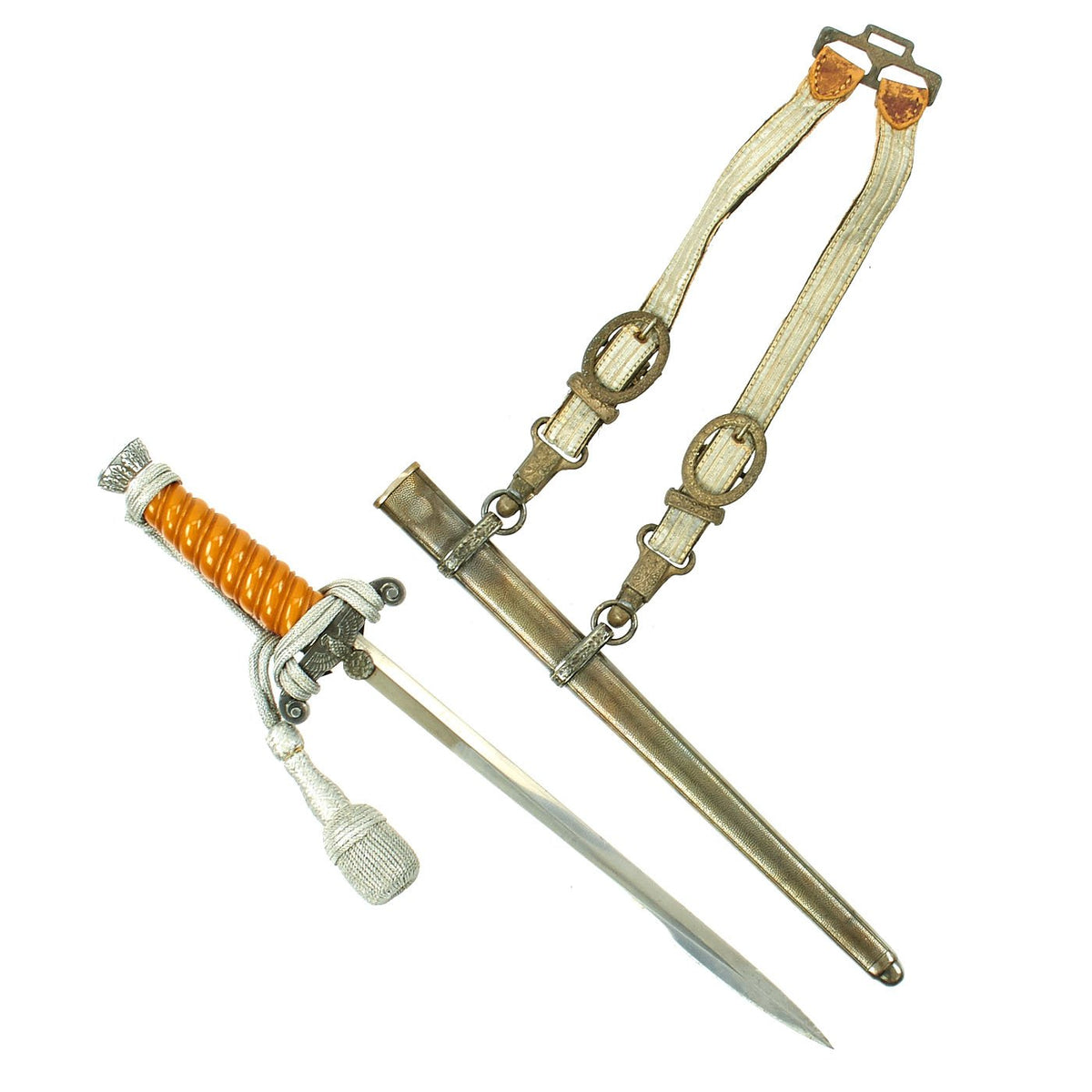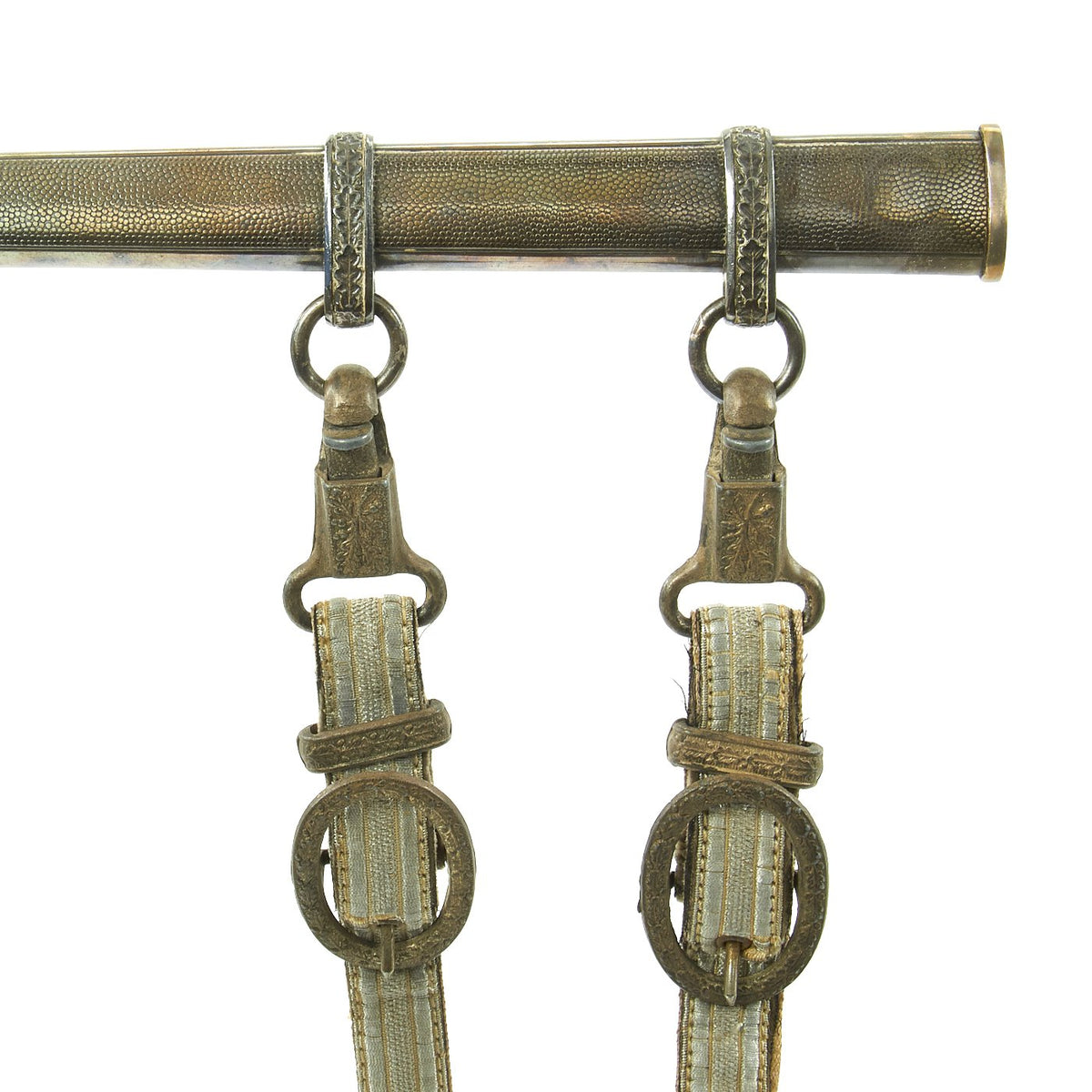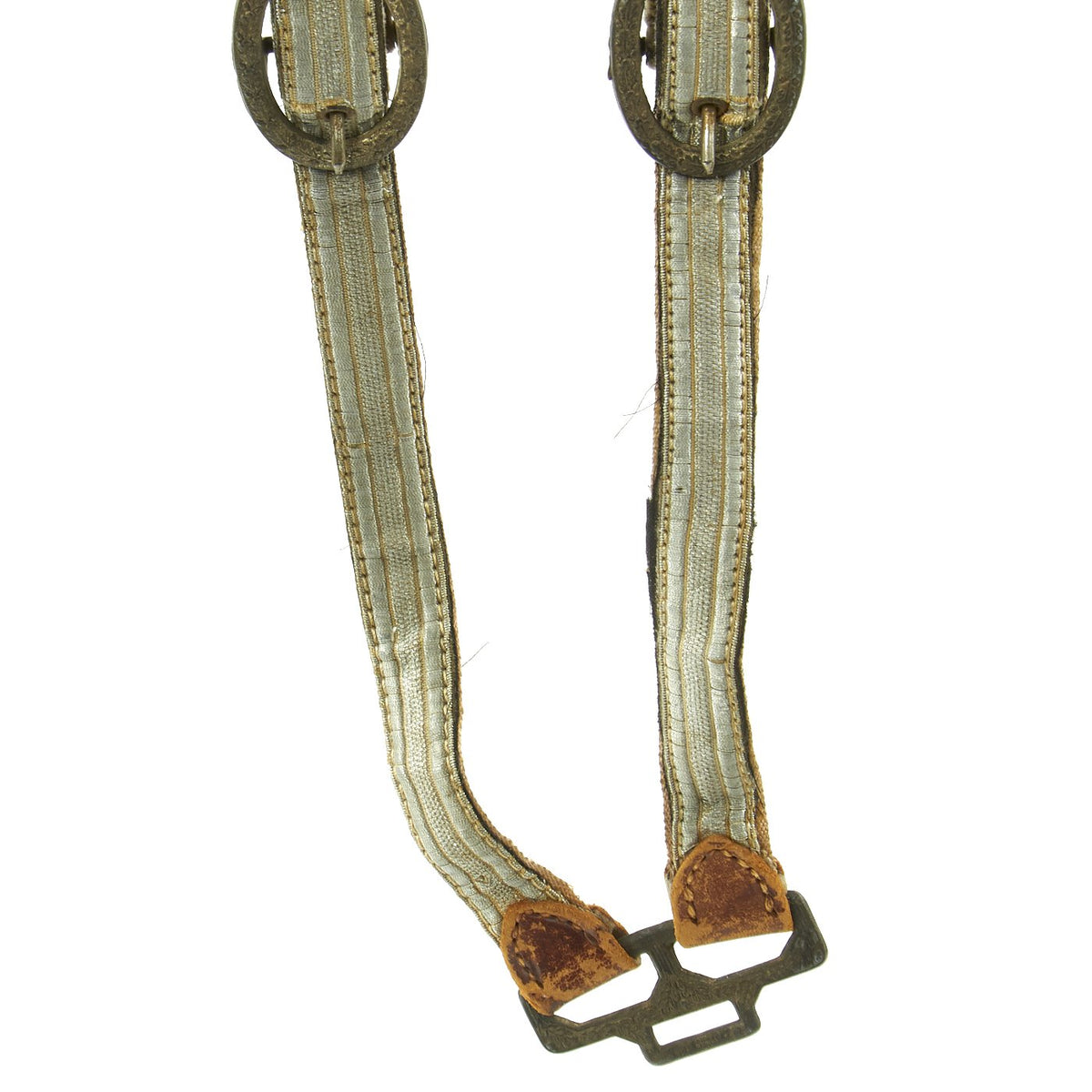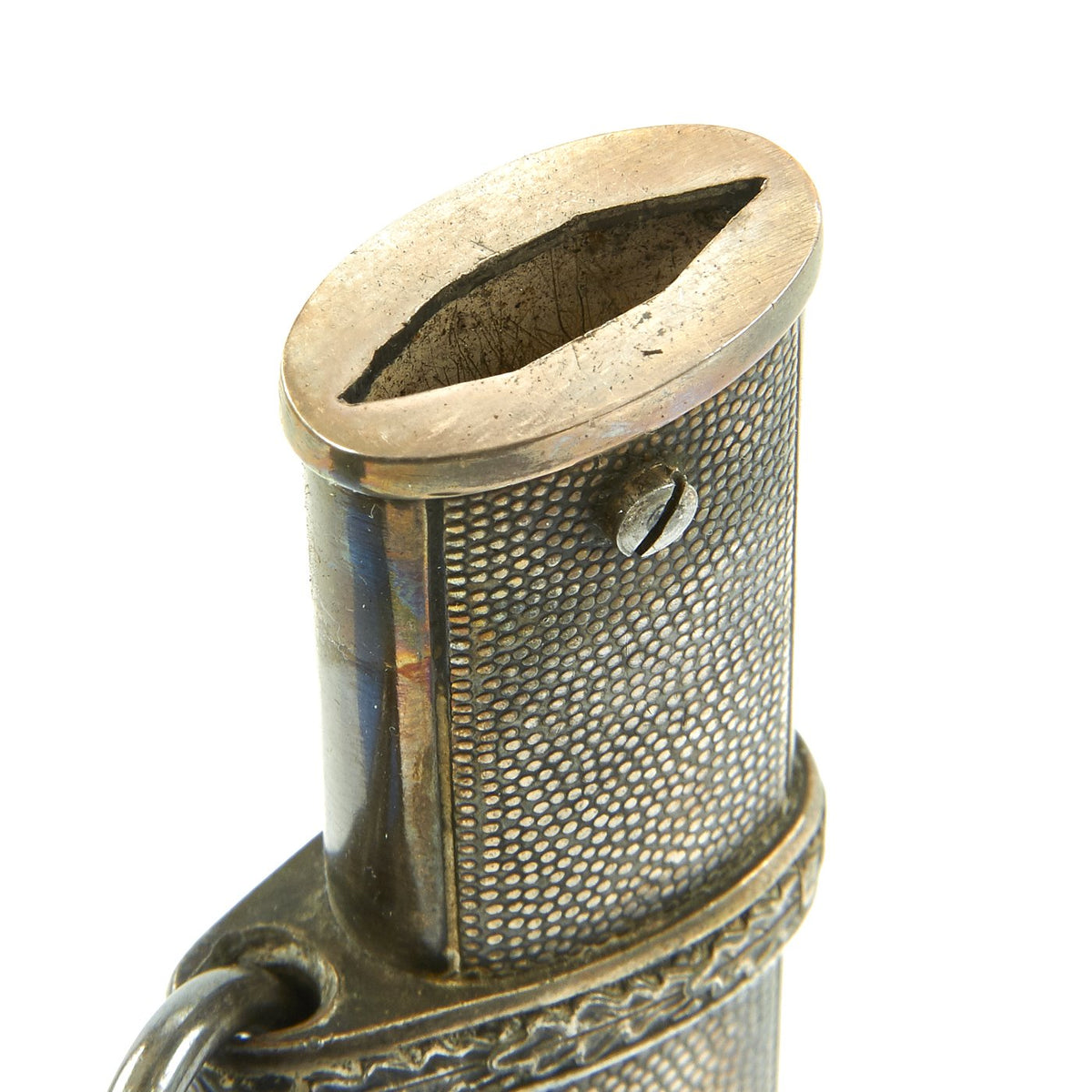Original German WWII Army Heer Officer Dagger by Carl Eickhorn with Hanger and Portepee – USGI Bring Back Original Items
$ 795,00 $ 238,50
Original Item: Only One Available. This is a very nice Army Officer’s Dagger, produced by the legendary Solingen-based firm Carl Eickhorn. It also appears to have an Army Serial number scratched into the blade, a wonderful bit of history.The pommel of this dagger is in very good condition, showing a little wear and scratching throughout the bottom, but nothing bad. Most of the plating has worn away, and this appears to be a dagger that was worn often.
The silver plated crossguard is in better condition, with a lot of the plating intact, with a great patina. The details throughout the characteristic Carl Eickhorn eagle are exceptional throughout the head, breast and wing feathering, talons and wreathed mobile swas. The grip ferrule is also silver-plated, and is in good condition with some wear, having been protected by the portepee.
The grip is has faded to a nice caramel orange, typical of celluloid grips from this period. This grip is in almost perfect condition throughout, with just a bit of staining and wear. Wrapped around the grip and cross guard is an original aluminum bullion thread portepee (sword knot), tied in the Heer fashion. It is in good condition as shown, with just a tiny bit of fraying.
The scabbard is a fine Carl Eickhorn example, and is plated zinc steel. This straight scabbard has very crisp, finely grained panels. The carrying bands have an excellent pattern of overlapping oak leaves and acorns, which are nicely enhanced, and show little wear. The throat is the thinner style, and has a single securing screw on the back of the scabbbard. It is silver or nickel plated, and has a lovely oxidized look. There is not really any flaking we can see, making this a great example.
Attached to the scabbard is a very good condition belt hanger, with functional pebbled spring clips with a great patina. The end clips are the more complex and desirable sliding type. The buckles and keepers are engraved with the same oak and acorn motif seen throughout the dagger. The hardware is marked D.R.G.M, indicating that these were registered in the German trademark office. The straps do show quite a bit of wear, especially on the velvet side. The ends have also both been repaired with leather where they wrap around the hanger attachment. This is a hanger that was used quite extensively.
The very nice blade is mostly bright throughout, showing almost all of the original cross grain in the light. The needle-like tip is still intact, with no bending. Overall finish does show some light staining in a few places, though the edge is still nice, with no major chips or sharpening. There is the usual runner wear on the blade surface. There is also a lovely bit of USGI personalization. Lightly scratched into each side of the blade is the number 242443809, which is the correct length for an Army Serial Number (ASN). We have not been able to identify this soldier, and leave it as a wonderful research opportunity. It is also scratched quite faintly, and we could not get it to show up on the photos.
The reverse ricasso is etched with the 1935-41 Eickhorn trademark: a seated squirrel holding a sword, with the word ORIGINAL above and the firm’s name and location, Eickhorn / SOLINGEN below. The original leather blade buffer is in place within the deep recesses of the guard.
According to J. Anthony Carter’s book, GERMAN KNIFE AND SWORD MAKERS, this company was founded in 1865 by Carl Eickhorn, and is arguably the most famous of all Solingen makers. Not only could the family trace their history back 500 years, but they could also demonstrate involvement in the hardening and grinding industries for the same period. Truly the nobility of Solingen Edged weapon dynasties. Eickhorn edged weapons are the most desirable of all makers.
A very nice example, ready to research and display!
The German Army (Heer) first carried a dagger beginning in 1935. The weapon was worn in lieu of occasions not demanding the wearing of a more formal sword. The dagger design was quite attractive featuring silvered heavy fittings with white or colored grip. The crossguard depicted a Wehrmacht open-winged eagle clutching a wreathed swas.
The pommel depicted oak leafing around the outer circumference. The scabbard had panels of pebble designs. Later produced examples were plated with nickel, and late war-made pieces were unplated, finished in a gray color metal. These daggers are often encountered with an aluminum portepee.
Fast Shipping with Professional Packaging
Thanks to our longstanding association with UPS FedEx DHL, and other major international carriers, we are able to provide a range of shipping options. Our warehouse staff is expertly trained and will wrap your products according to our exact and precise specifications. Prior to shipping, your goods will be thoroughly examined and securely secured. We ship to thousands clients each day across multiple countries. This shows how we're dedicated to be the largest retailer on the internet. Warehouses and distribution centres can be located throughout Europe as well as the USA.
Note: Orders with more than one item will be assigned a processing date depending on the item.
Before shipping before shipping, we'll conduct a thorough inspection of the items you have ordered. Today, the majority of orders will be delivered within 48 hours. The delivery time will be between 3-7 days.
Returns
The stock is dynamic and we cannot completely manage it because multiple stakeholders are involved, including our factory and warehouse. So the actual stock may alter at any time. It's possible that you may not receive your order once the order has been made.
Our policy is valid for a period of 30 days. If you don't receive the product within 30 days, we are not able to issue a refund or an exchange.
You can only return an item if it is unused and in the same state as the day you received it. You must have the item in its original packaging.
Related products
Uncategorized
Uncategorized
Uncategorized
Uncategorized
Armoured Fighting Vehicles of the World: AFVs of World War One (Hardcover Book) New Made Items
Uncategorized
Uncategorized
Uncategorized
Australian WWII Owen MK1 Machine Carbine SMG Custom Fabricated Replica with Sling Original Items
Uncategorized
Uncategorized
Uncategorized
Uncategorized
Band of Brothers ORIGINAL GERMAN WWII Le. F.H. 18 10.5cm ARTILLERY PIECE Original Items
Uncategorized
Uncategorized
Uncategorized
Armored Burgonet Helmet & Polearm from Scottish Castle Leith Hall Circa 1700 Original Items
Uncategorized
Uncategorized
Uncategorized
Uncategorized
Uncategorized












































































